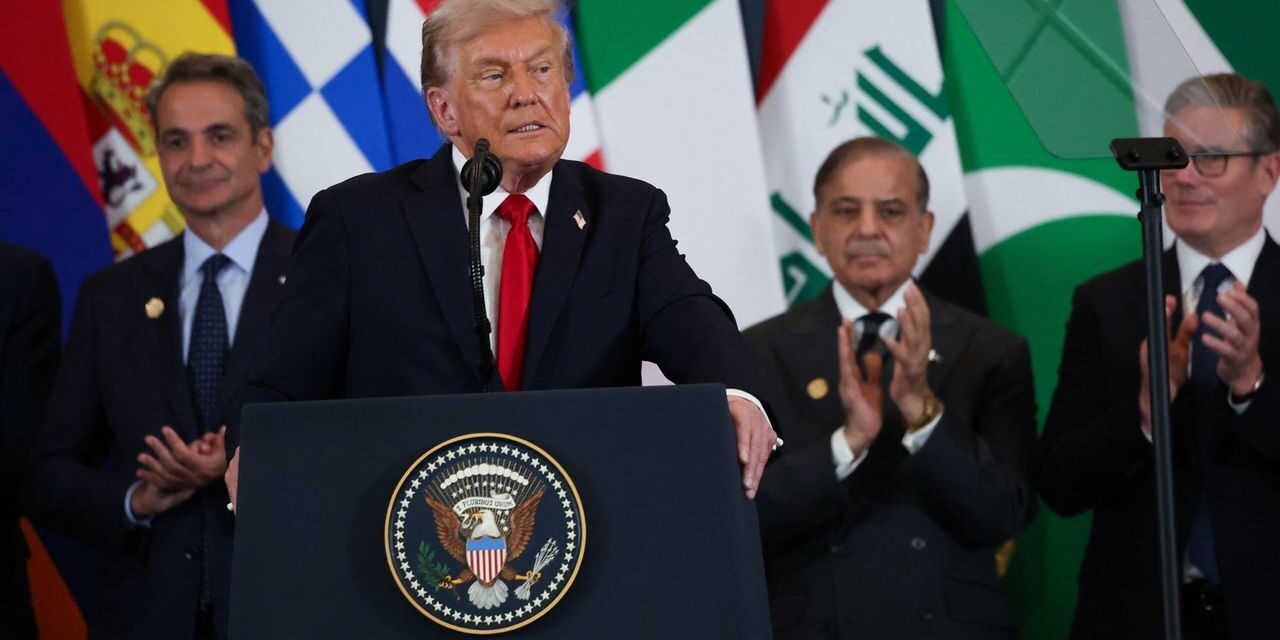Donald Trump speaks at an international conference in Sharm El-Sheikh, Egypt, October 13, 2025 (Sky)
Originally published by The Conversation:
EA-Times Radio VideoCast: Gaza Ceasefire, Trump’s “Ego Show”, and What Happens Next
EA on ANews and Talk TV: Gaza Ceasefire — After the Hostages-for-Detainees Exchange
Following Monday’s Middle East summit in Sharm el-Sheikh, Egypt, Donald Trump’s Gaza ceasefire deal has been compared in the media to the Good Friday Agreement, which brought an end to the conflict in Northern Ireland, and the Dayton Accords, which achieved a (so far) lasting peace in the Balkans.
But Trump’s deal differs significantly from both. It is largely imposed from the outside. It’s highly transactional in nature. And it lacks a clear blueprint as to what happens next.
But it’s worth noting that one of the defining things about Donald Trump as a politician is how he will make an exaggerated claim about an achievement which then sets the framing for the rest of the world to react. So he boasted of his ceasefire deal that it was “not only the end of war, this is the end of the age of terror and death”.
Others have run with the Good Friday Agreement comparison. The Christian Science Monitor asserted on October 2, the day after the US president unveiled his 20-point plan: “Mr. Trump’s blueprint rests on the hope that what worked in Northern Ireland will work in Gaza, and on one assumption above all: that Israelis and Palestinians are ready to accept that continued violence won’t get either of them what they want.”
This is no small assumption, and there is nothing to suggest it has any foundation.
What has been agreed between Israel and Hamas is an end to the fighting and the release of detainees and hostages. But serious obstacles remain. The disarmament of Hamas is by no means a done deal — in fact it looks less likely by the day.
The withdrawal of Israeli troops from Gaza also looks to be a non-starter. The plan’s text remains very vague as to the extent the Israel Defense Forces will move out of Gaza, if at all. Questions of governance, the agreement of a process towards a Palestinian state, and the cost of reconstruction have yet to be resolved.
But the most important hurdle in the way of this ceasefire deal holding firm is the profound lack of trust between the parties.
Set against these obstacles, the ceasefire and return of the hostages and release of Palestinian prisoners — momentous though they have been — represent the low-hanging fruit of any end to the conflict. They should be seen as the first steps on a difficult and uncertain diplomatic path that has been characterized by decades of setbacks and political failure.
By contrast, the Dayton and Northern Ireland peace processes were painstakingly negotiated between all the parties in advance through detailed diplomacy, resulting in complex power-sharing arrangements. They were guaranteed by intricate governing structures that addressed the long-standing sectarian divisions through detailed constitutional changes and new institutions.
Aspiration Is Not Agreement
No such details are part of “The Trump Declaration for Enduring Peace and Prosperity”. It turns out this is a 462-word document signed in Egypt by a hastily arranged group of international leaders that notably did not include representatives from Hamas or Israel.
The text states: “We, the undersigned, welcome the truly historic commitment and implementation by all parties to the Trump Peace Agreement, ending more than two years of profound suffering and loss – opening a new chapter for the region defined by hope, security, and a shared vision for peace and prosperity.”
While laudable, aspiration is no substitute for detailed agreement. At this point, Trump’s claims appear to be a case of premature congratulation.
Given how tentative the peace agreement is and the fact that October’s ceasefire looks remarkably similar to that which was agreed and then breached in January 2025, why is this being treated with such fanfare? Is it really, to quote Trump, “the historic dawn of a new Middle East”?
Beyond the obvious fact that Trump loves the adulation, there are political calculations in play. If the US is openly and obviously committed to the peace process, it is more difficult for the opposing parties to reopen hostilities without the risk of incurring American displeasure for ruining their achievement. Violators might reap the wrath of a President who felt his achievement and chances of a Nobel Peace Prize had been undermined.
What’s In It For Other Leaders?
The presence of so many world leaders at Trump’s peace summit requires a different explanation. French President Emmanuel Macron, UK Prime Minister Keir Starmer, and Canada’s Mark Carney might be forgiven for wondering why their presence was required as extras in this performative political theater.
Behind their smiles and applause, they must have been acutely aware that such optics are damaging to the way they are viewed by their domestic public and press – and that their presence will be criticized as evidence of supplication to Trump’s adulation. The appearance in Sharm el Sheikh of Hungary’s Viktor Orbán added to the impression that Trump had gathered his fan club in Egypt.
Why they were willing to attend is equally revealing. As well as being seen to be supportive of the peace process and being keen to add to its momentum — thus raising the cost of its failure — Carney, Macron, and Starmer are playing a longer game. They hope to nudge Trump in the direction of further acts of international leadership.
Most notably, they are keen for Trump to embrace his self-identification as a “peacemaker” to pressure Vladimir Putin to end his aggressive war against Ukraine.
Like most second-term US Presidents ,Trump is concerned for his legacy. If flattering his ego directs his energies towards a lasting Gaza settlement, then their part in this iteration of the Trump Show should probably be judged by history as worthwhile.


John Bolton indictment says suspected Iranian hackers accessed his emails, issued threats : https://cyberscoop.com/john-bolton-indictment-says-suspected-iranian-hackers-accessed-his-emails-issued-threats/
“Suspected Iranian hackers infiltrated former national security adviser John Bolton’s email account and threatened to release sensitive materials, his indictment alleges. The indictment on charges that Bolton mishandled classified information, released Thursday, comes after President Donald Trump’s unprecedented public call for the Justice Department to prosecute his enemies. Bolton served under Trump in his first term as national security adviser and since has become a critic. The passage of the indictment related to the Iranian hackers seeks to demonstrate a representative of Bolton knew his personal emails included information they shouldn’t have.”